
A recent BBC article titled, “Is there a Sikh code of silence on sexual grooming?” discusses how six men were jailed in the UK for offences including child prostitution – the case receiving significant attention since it was the first high-profile case involving a Sikh victim of sexual abuse leading to convictions.  As a follow up to the article, BBC’s Inside Out London showcased a 30 minute report uncovering the “hidden scandal of sexual grooming of young Sikh girls by Muslim men.”  The show is receiving much attention – particularly within the Sikh community – with much discussion around the tense issue, race relations and what’s being done (or not) to address the problem.
The documentary (which you can view below) showcases real cases where girls courageously discuss their experiences being “groomed” and forced into prostitution. Â Sexual abuse is a serious issue within many communities, the Punjabi community is no exception. Â Unfortunately, a lack of openness to talk about the issue often leaves victims and their families living in isolation. Â The report identifies the work of an organization within the UK called the Sikh Awareness Society that provides some assistance to these young girls and often bringing to light the criminal activity which local law enforcement agencies often neglect. Â The organization has committed to traveling to all the Gurdwaras in the UK to provide information about the issue and to help parents understand what their children may be experiencing. Â While it is unclear how large the issue really is or how long it has been occurring – it is nevertheless significant that this discussion is even taking place (especially in Gurdwaras!).
I found the report to be troubling for several more reasons.
Guest blogged by Mewa Singh
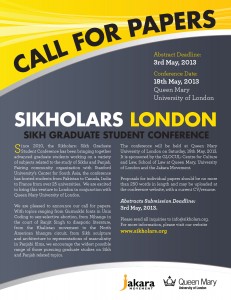 Earlier this year the Center for South Asia at Stanford University along with the Jakara Movement hosted its 4th annual Sikholars Conference (see the recap here). Â This successful endeavor bringing the latest academic research with an engaged community audience allows for fruitful discussion and exchange. Â Not limiting this event only to California, Sikholars conferences and workshops have been previously held in British Columbia, Canada and now in London, UK. Â Teaming up with Queen Mary College, University of London and Singh Sabha Southall, the Jakara Movement is proud to present Sikholars London.
Earlier this year the Center for South Asia at Stanford University along with the Jakara Movement hosted its 4th annual Sikholars Conference (see the recap here). Â This successful endeavor bringing the latest academic research with an engaged community audience allows for fruitful discussion and exchange. Â Not limiting this event only to California, Sikholars conferences and workshops have been previously held in British Columbia, Canada and now in London, UK. Â Teaming up with Queen Mary College, University of London and Singh Sabha Southall, the Jakara Movement is proud to present Sikholars London.
For those in the UK (looking at you @Blighty), hope you get to check it out and experience Sikholars – London. Â For more information visit their website here.
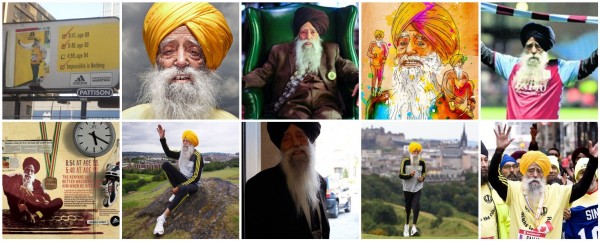
We love Sardar Fauja Singh. Â We really, really do.
On Sunday, Fauja Singh will run his final race in Hong Kong at the tender age of 101.  Jezebel recently covered Fauja Singh in a piece about  women’s rights, and just today Jordan Conn wrote a compendious and inspiring article for Outside The Lines on ESPN about Fauja Singh’s life and the “missing” Guinness Book of World Records title.  This article, along with stunning photographs, spread like wildfire on Facebook and Twitter today – reminding us just how much the world loves Fauja Singh and what he represents.
On the first day of training, Fauja arrived limber and energetic and dressed, as he believed was perfectly appropriate, in a dazzling three-piece suit. Harmander told him he needed a wardrobe change. After adamant protests, Fauja relented, ditched the suit and bought running gear. He showed up every day after that, building his routine around his training schedule. His mileage increased as the weeks passed. Race day arrived. After 6 hours and 54 minutes, 4:48 behind winner Antonio Pinto, Fauja crossed the finish line. At age 89, he was a marathoner. Soon, he would be a star.
We will be wishing you well on Sunday, Fauja Ji! Â Thank you for continuing to be such an activist and a positive soul and for reminding us of the importance of health and happiness.
– The Langar Hall
This past weekend, I attended the second annual Sikh Feminist Conference at the University of British Columbia in Vancouver. A friend posted a concise review of the conference here which I would encourage you to read. I’ll just reiterate two points made – the first being the discussion around whether the western concept of Feminism fits within Sikhi. What does it mean to call oneself a Sikh Feminist or even a Male Sikh Feminist? Many participants at the conference felt the words “Sikh” and “Feminist” were redundant and that it was not necessary for us to try to mold to western definitions of feminism when our own faith clearly defines the concept of [gender] equality. On the other hand, others argued that the word is powerful enough to raise and question the issue of patriarchy that continues to exist within the community. The discussion reminded me of a similar conversation that was had at the Faith and Feminism panel, featuring Sikh women, which took place last year in NYC. About the panel discussion, the author writes,
The core values in Sikhism, particularly the human rights element, were what informed [the panelist’s] views on issues, including women’s rights. She has taken the word “feminism” out of the equation, and transplanted the values of it back into Sikhi, and reminded us that anyone who adheres to the principles of Sikhism and to the words of the Guru Granth Sahib has many labels, feminist, humanist, and activist are just some of them.
The second point is the important link between theory and practice within the Sikh community. I want to highlight this in two ways. The first being that while it has been established that the Gurus emphasized living in an eco-friendly way, it’s clear that as a community we are still working to close the gap – from melas to gurdwaras to within our own homes – our practice of living in an eco-friendly way could use some improvement. EcoSikh sponsored the Sikh Feminist conference and it’s presence was felt very thoughtfully throughout the day (biodegradable utensils, compost, recycling etc!) and it was inspiring to see our community not just talk about it in theory, but actually put it into practice.
Another discussion was around the concept of izzat or honor, whether it impacts both men and women, how it manifests differently for men and women and why it continues to be a topic of discussion when theoretically, our Gurus gave us the guidance and tools to live in an egalitarian society. The concept itself has been one of discussion on our blog too – particularly around what it means to a family and to a community. We are once again reminded of this issue with the recent news of Baljinder Kaur, a pregnant woman from Yuba City who was arrested over the weekend, just before the Sikh Women’s conference, for apparently killing her mother-in-law.
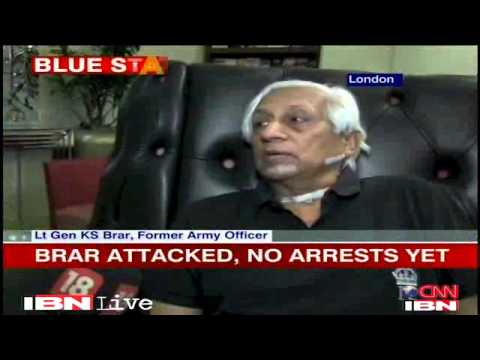 Yesterday’s news about the attack on KS Brar has excited, angered, inspired, and agitated many Sikhs throughout the world.
Yesterday’s news about the attack on KS Brar has excited, angered, inspired, and agitated many Sikhs throughout the world.
Many have questioned the Indian media’s initial assumption, before even the facts had arrived. Still others are wondering if the news is even factual. I have seen numerous postings on social media, believing that the attack was just a fabrication in order to make Sikhs appear ‘violent’ and ‘extreme’, especially after the recent goodwill expressed by some channels in the US and abroad after the recent Wisconsin Massacre. Finally, our brothers and sisters at Naujawani have written an intriguing article asking larger questions about a more sinister timing of all events (though not sure if I agree, well worth a read!).
I believe that the case of Kulbir Singh Barapind and Daljit Singh Bittu is extremely important, but that warrants a separate post. I will return to that issue at a future time.
Personally I am quite surprised that no names have appeared yet, as I figure someone would probably take credit and I wouldn’t imagine the names could be held a secret for too long within the community, especially if those that confronted him were young, as the claim is being made. Still I think that I want to take this conversation in a different direction. How do we ‘present’ SikhISM and its implicationsi?
Guest blogged by Naujawani Sardar
 Sikhs in the UK celebrated a victory of sorts today with the news that the national broadcaster, the BBC, ‘regretted’ comments made by a presenter on their digital radio station, the BBC Asian Network. On 13 March, DJ Nihal Arthanayake had suggested on his daily call-in show that Sikhi was “made up from other religions i.e. Islam and Hinduism” [see related article]. When corrected by a listener who texted in to challenge the presenter’s comments, Nihal showed shocking arrogance in asserting that he himself was correct and replied that he knew “more about your religion than you do”. But today’s news is only a victory of sorts with Lord Inderjit Singh of the Network of Sikh Organisations describing it as “not a very good sorry” and in this writer’s humble opinion, a mere bone to keep us from tackling the real problem.
Sikhs in the UK celebrated a victory of sorts today with the news that the national broadcaster, the BBC, ‘regretted’ comments made by a presenter on their digital radio station, the BBC Asian Network. On 13 March, DJ Nihal Arthanayake had suggested on his daily call-in show that Sikhi was “made up from other religions i.e. Islam and Hinduism” [see related article]. When corrected by a listener who texted in to challenge the presenter’s comments, Nihal showed shocking arrogance in asserting that he himself was correct and replied that he knew “more about your religion than you do”. But today’s news is only a victory of sorts with Lord Inderjit Singh of the Network of Sikh Organisations describing it as “not a very good sorry” and in this writer’s humble opinion, a mere bone to keep us from tackling the real problem.
The daily call-in show on the BBC Asian Network has been steadily gaining in notoriety over the last 18 months fuelled largely by an increasing move towards discussions that court controversy. From 1pm-3pm, Monday to Friday, listeners tune in to hear the presenter, callers and occasionally guests debate a topical issue that is usually relating to a section of the South Asian community, followed by a sparse selection of music and further, more light-hearted discussion. Sometimes the initial debates have been incredibly engaging and informative, on other occasions they are needlessly provocative and disparaging.
In recent months, I have been called upon as a contributor to the show a handful of times, speaking live on air as a Sikh voice and I have publicly commended the production team of the show on two separate occasions for talking about challenging issues that are otherwise ignored by mainstream media. Following a discussion show about the recent Immortal Productions release ‘Jaago’ , a show to which I contributed by a pre-arranged telephone call, I took to Twitter to voice how fair I thought the production team had been in allowing Sikhs such as myself to make our voices heard about the rife corruption, inequality and poverty prevalent in the Indian State of Punjab over the last sixty years. Having been in Sikh political circles for over two decades now, I was unsurprised by the immediate level of hate I received from fellow Sikhs for being seen to ‘support’ Nihal and the BBC Asian Network on that occasion, but it did make me realise that Nihal in particular seemed to be drawing much of the ire. Whilst this is to some extent deserved, it would be foolish to reason that replacing the presenter might provide scope to change direction. But this is a difficult reality to impart upon a very unforgiving Sikh diaspora. I made the mistake of trying to explain to a young Sikh female on Facebook that a presenter of a call-in show usually acts in accordance with the briefing given to them by the production team, who in-turn are loosely guided by the direction given to them from the station controller or management, and that if she did have any complaints here they ought best be directed towards the BBC as well as the individual. She proceeded to reply that I must be a blind fan of Nihal’s and was planning on giving him a siropa. Oh the joys of ‘debating’ on social media(!)
Co-blogged by JooKay Singh and Jodha
Our fellow langa(w)r-iter – Navdeep Singh highlighted the dominant pop genre of Punjabi music that celebrates nihilism and suicide through political complicity and destitution. Today, we highlight another form of music that has reached new heights in the shadow of the Shaheed.
UK-based producer Tru-Skool’s latest dharmic-track, ‘Beant Satwant Da Badla‘, which will be part of the 10th Shaheedi Immortality album, has topped the BBC Official Asian Download Chart this weekend gone. This isn’t the first time one of the Shaheedi Immorality tracks has been on the BBC Asian Network playlist (Tigerstyle’s Son of a Sardar and Jhooldey Kesri Chande have previously been played by Bobby Friction, Nihal & Adil Ray amongst others), and some would argue this track isn’t pushing the envelope musically or lyrically, since the Immortal Production (IP) collective have been putting out similar tracks for the past 10 years. So, what’s different, and is this a flash-in-the-pan riding on the back of kesri lehar, or is there more?

Previous IP tracks were given play time on the BBC courtesy of their association with Tigerstyle, who are well respected in the UK as innovative producers, rather than for the tracks themselves; diligent listeners will have noted that the songs were also edited to remove ‘controversial’ lyrics. In Jhooldey Kesri Chandey, for example, the first thirty seconds or so contained part of a speech by Baba Jarnail Singh Bhindrawale, and was removed entirely. Beant Satwant Da Badla, by contrast, has received air time by virtue of being the most officially download ‘asian’ track last week in the UK and was played unedited.
UPDATED: All of a sudden I remembered a video from KPS Gill. Readers on this site are aware of this murderous sadist, but maybe it is still worthwhile to juxtapose his lies with the findings announced this week.
All of our attention shifted towards Punjab last week. There was some interesting developments early this week. One is that Voices for Freedom, a non-government organization, based out of Punjab filed a public interest litigation (PIL) petition against the Sukhbir Badal’s appointee for Director General of Police (DGP) Sumedh Saini. Saini is a well-known human rights abusers and was involved in the many murders, “disappearances”, and torture during the 1980s and 1990s. From the media reports, while the petition may not go far, hopefully it does center some more attention on just the type of thugs that the the Badal Mafia appoints.
Another note from Punjab came yesterday when the National Human Rights Commission (NHRC) of India announced that they would pay Rs. 175,000 (about $3,500) to 1,500 families in the Amritsar district for the murder of their sons. Of course there is no culpability, just an attempt to buy silence. Well-known human rights lawyer Navkiran Singh of Chandigarh has rightly state:
It is too little too late and why only from Amritsar District? Khalra gave example of Amritsar district, but wanted an inquiry for the whole of Punjab. Imagine we had to pursue the matter in the NHRC for 17 years for this little justice.
UPDATE: I just wanted again to stress the lies that KPS Gill has restated for years. See this interview with an Australian journalist, when asked point-blank about the case of illegal cremations, KPS Gill lies without hesitation. Contrast this where the NHRC admits it occurred and even pays out money to families, though without casting any blame or responsibility. I have yet to see a true Indian journalist expose KPS Gill for his lies. Unfortunately they continue to lionize him, assuring that impunity continues – whether in Punjab, Delhi, Gujarat, Kashmir, and many other regions of South Asia.

Guest post by Naujawani Sardar
The title to this article might have conjured up images of a cowboy-style shoot ’em up between turban-donning, mounted riders, and whilst I would welcome development of such an idea into a film, sadly that’s not what i’m writing about. I am Sikh, Punjabi and Western (English) and like every other person growing up in the West I am challenged by the cultures of all three identities. I am also in my early thirties – if I think i’m having a tough time coming to terms with these uniforms, I am only thankful I am not ten years younger in the modern World.
Growing up in the West can be mentally taxing for young Sikhs. Whether English, American, Canadian or European, there pervades a Western notion of lifestyle, opportunity and prosperity that occasionally challenges the practices most of us engage in as Sikhs, and certainly impinges on the way we are brought up in Punjabi households. There is a wide array of ways in which the cultures denoted to us by birth clash with one another, from career choices to personal relationships, hairstyles to language usage. How we deal with these culture clashes will differ from individual to individual and whilst the maxim that a Sikh is a Sikh irrespective of their nationality, there is a growing need to support young people and help them to deal with life in a way that reflects the road they wish to travel on.
Young people find support from varied sources including friends, family, schools and independent organisations. The latter is what I would like to focus on seeing as this is the least regulated group from that list and arguably can have the most influence. In this context, independent organisations are extra-curricular clubs, societies and charities; places that provide essential skills in team-working, discipline and communication through playing a sport, learning a language or providing a service. Whilst engaging in an activity, young people are at least purportedly provided with guidance on everyday life and this is clearly seen in the confines of the Sikh experience: gatka akhare, Punjabi language classes, Khalsa/Gurdwara football teams, Sikh activist groups, and even online communities such as The Langar Hall.
In late 2009, we wrote a post about the growing number of homeless Punjabis and Sikhs living in Southall. Almost three years later, the situation in Southall continues to concern us. A recent article from the BBC discusses the plight of these young men who seek voluntarily deportation back to India but who, without documents, are unable to navigate an unforgiving bureaucratic situation.
Jagdeesh pulls away a piece of cardboard revealing a tiny hole in a concrete wall. He invites me to climb through, declaring: “This is my home, come in.”
“I was told that life was good here. It’s not just me, other boys came for work,” he says. “You can see what state we’re in, there’s no work, no government help.” Jagdeesh has cut himself off from his family, saying he is ashamed of his failure to find work and would rather they thought he was dead than knew he was living in filth. “They sold land and took out loans to get me out of India. What can I say to my family back home? The money we’ve invested is lost,” he says. [link]
According to figures from the UK Home Office, voluntary departures have risen steadily over the past few years, from 335 in 2005 to 15,537 in 2010. While many of these cases have been logged with the UK Border Agency, it seems that the Indian High Commission is dragging its feet on processing the cases. According to the article, the UK Border Agency admits that establishing the identity of illegal immigrants in order to issue them with emergency travel documentation is a “complex” process and that the time it takes to process these individuals varies by case. One individual, a man in his 30s, has been waiting for three years.
Many of these individuals abuse drugs and alcohol as a way to cope with the situation. Their thoughts often turn to suicide. Their only support system is each other and the majority of them haven’t even told their families, back in Punjab, about their broken dreams. It’s a difficult situation for these men – their lack of options in Punjab drives them to seek opportunities abroad but this promise of prosperity is not always what it seems to be.
As our UK co-blogger, Naujawani Sardar, states, “There are many questions being asked about the problems facing masses of illegal Punjabi immigrants in West London, but the most important questions that will prevent this situation from reoccurring in the long-term are not being asked: Why do so many youth risk everything to leave The Punjab? What is being done to curtail the agents that are facilitating their travel? And, what repercussions do UK citizens face for exploiting illegal immigrants?”
Guest blogged by Naujawani Sardar
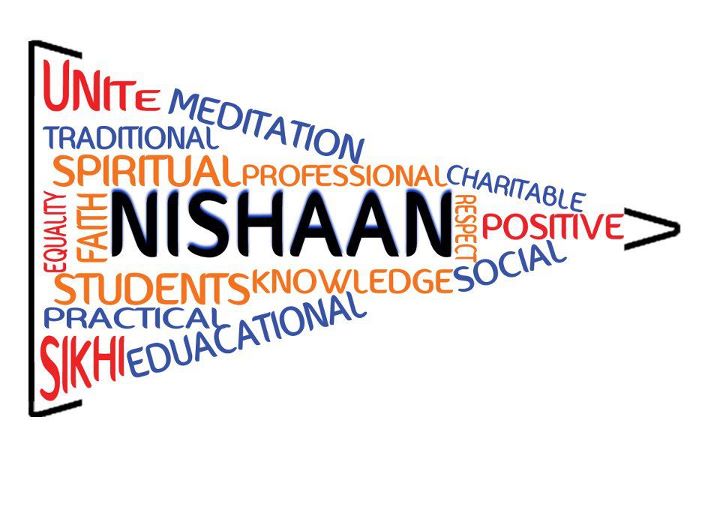 There has been a lot of talk about the SGPC elections recently, even over on our blog. And it got me thinking about a whole range of things from ‘selection vs. election’ to Sikh bodies outside of Punjab. My life in Sikh circles has been positively fascinating for over two decades now, but one of the things I have found most difficult to deal with has been the tension that arises around Sikh representative bodies. Before you stop reading, I’m not going to write about the SGPC – although what I’m writing about could quite easily fit the world of any organisation that represents Sikhs, and specifically those who have had to face false accusations.
There has been a lot of talk about the SGPC elections recently, even over on our blog. And it got me thinking about a whole range of things from ‘selection vs. election’ to Sikh bodies outside of Punjab. My life in Sikh circles has been positively fascinating for over two decades now, but one of the things I have found most difficult to deal with has been the tension that arises around Sikh representative bodies. Before you stop reading, I’m not going to write about the SGPC – although what I’m writing about could quite easily fit the world of any organisation that represents Sikhs, and specifically those who have had to face false accusations.
“Nishaan is a new organisation consisting of university Sikh Societies across London and the South East of England. It is created on the principle of ‘for the students by the students’.”
That is taken directly from the biography of ‘Nishaan‘ – a body of university students at institutions in London who have been collaborating and working closely together for the last year. In actual fact some amongst this group of students and this movement itself began in earnest four years ago when one particular University Sikh society at Imperial College London established an annual meal and gathering of Sikh socs from around the capital; they called the event ‘Collaborations’. Following that, students looked to ‘collaborate’ more often, but in reality it didn’t work efficiently because communication was poor, organisation was overly dependent on single individuals and the age-old division of jatha-affiliation reared its head.
For Update – see bottom of post
Although far from my home (hopefully @blighty and @joo kay singh can share), is an intriguing exhibit celebrating our beloved Darbar Sahib (erroneously called the Golden Temple) at Amritsar.
Nearly 80 artefacts from the past 200 years have been collected for this exhibit on display in central London. Most of the items are said to be from private collections and this will be the first time they have been publicly displayed. The entire exhibit is being organized by the UK Punjab Heritage Association and there is indication that it may travel.
Until then, enjoy the art through this BBC Video on the exhibit (unfortunately the BBC does not allow you to embed, so you’ll have to follow the link).
In conjunction, it seems Sathnam Sanghera of A Boy With a Top Knot fame will be chairing a panel at the upcoming DSC South Asian Literature Festival (Oct 7-24) titled: The Golden Temple of Amritsar: Reflections of the Past on October 14. The panel will highlight the Muslim rababi tradition of kirtan from one of the descendants of Bhai Mardana – Bhai Ghulam Muhammad Chand. Unfortunately, it will also feature that most media-astute of the neo-Nihangs and pedlar of neo-Sanatan nonsense – Nidar Singh – who now claims himself to be the “Last Sikh Warrior” (I wonder if he could take on Tom Cruise, who we all know is the Last Samurai). Regardless, the event is free and definitely worth a visit.
Our UK readers, let us know your thoughts!
Guest blogged by Eren Londonwala
Each day I walk down Ferry Lanein Tottenham to my workplace. On Friday 5 August a police cordon blocked my usual route. I learned later that police had shot dead 29 year-old alleged gang-member Mark Duggan the night before. The precise facts remain unclear but early reports suggesting an exchange of fire between police and the dead man have been undermined – Duggan’s gun wasn’t discharged. This was a tragedy I thought and perhaps another instance of excessive force by police in a poor London borough with a large black population. Few anticipated what was to come.
route. I learned later that police had shot dead 29 year-old alleged gang-member Mark Duggan the night before. The precise facts remain unclear but early reports suggesting an exchange of fire between police and the dead man have been undermined – Duggan’s gun wasn’t discharged. This was a tragedy I thought and perhaps another instance of excessive force by police in a poor London borough with a large black population. Few anticipated what was to come.
On the next day members of Duggan’s family – who by then had still not been contacted by police – and other locals went to Tottenham Police Station for answers and to stage a peaceful vigil. Senior police ignored the group and around this time a young female, remonstrating, was apparently “set upon by police with their batons”. Unlike a previous contributor to this blog, who described this incident as “relatively minor”, given the understandably heightened passions live then in Tottenham, I feel the police action was heavy-handed and incendiary. I invite readers to view the evidence and make up their own minds. It was after these events that Tottenham, and in subsequent days other areas in London and England, erupted into the worst civil unrest for a generation.
Then, the causes were unmistakeable – racist policing of ethnic minority communities and social deprivation. So, like some others, I viewed the outbreak of recent violence as a reaction to the continuation of unresolved problems, sparked by the suspicious killing of Duggan – an understandable, and even legitimate, rebellion in other words. The fact that police cars were among the first targets of the Molotov bombs seemed to confirm this. Yet, as the days unfolded, and disorder spread throughout the capital and country, a distinction between the two eras became apparent: 2011 was marked, to a far greater degree than 1981, by opportunist looting which came to devastate as many small independent businesses as insured corporate chains and, amid the chaos, most tragically, led to further loss of life with Duggan’s death being all but forgotten.
Guest blogged by Naujawani Sardar
When the riots began in London last Saturday, we all thought they were a one-off incident and the world would be back to normal by Monday. Instead we awoke to find that more shops had been looted, buildings were still being set ablaze and that the rioters were now widening their search for new canvases to destruct. The thought was certainly there in the back of my mind, throughout my working day on Monday, but I think I purposely ignored it, hoping that it just would not happen: could a gurdwara be targeted?
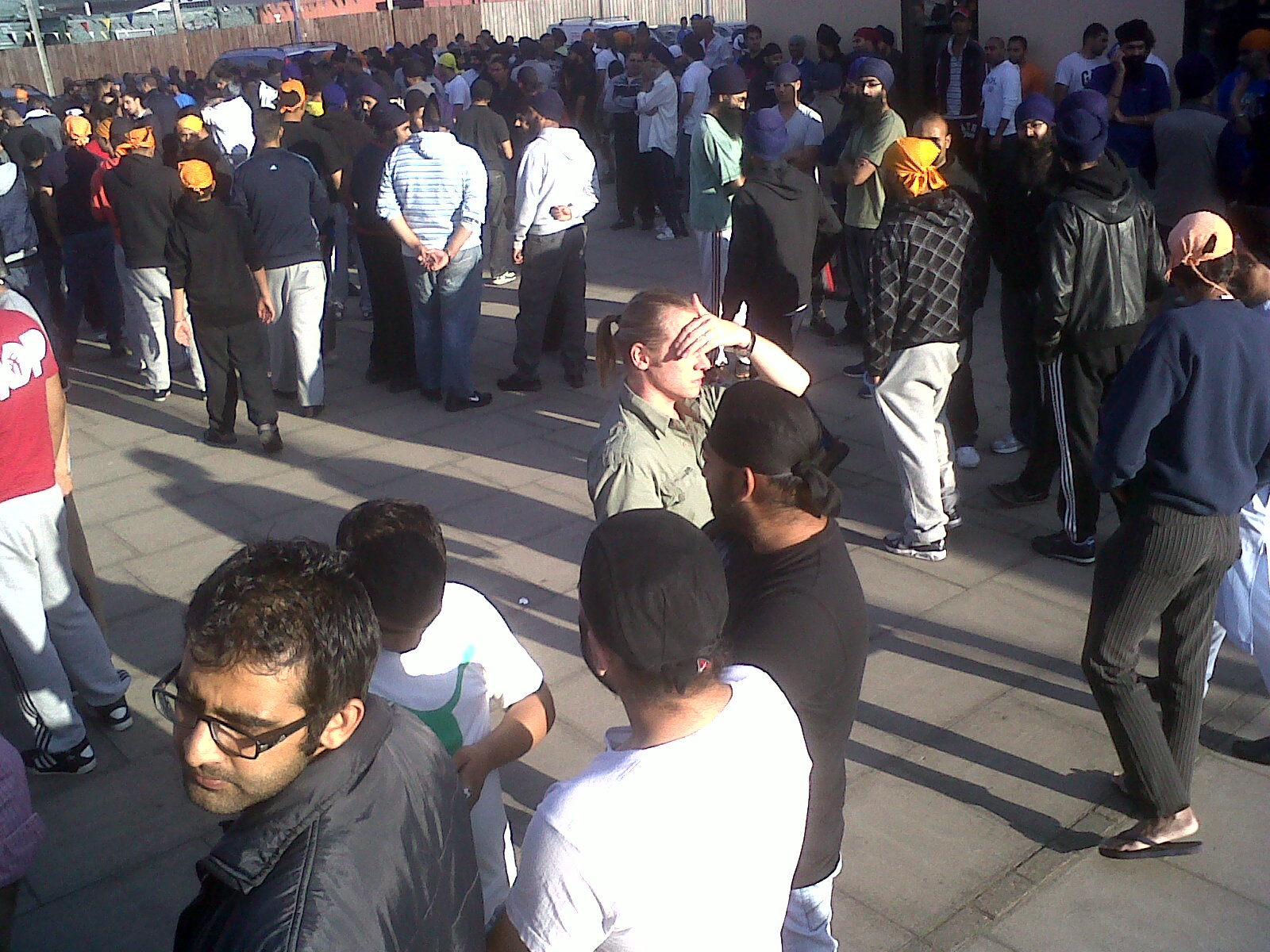 A small number of Sikhs however did not let the thought fall out of sight and continued to monitor the situation. Having realised that a problem may arise, albeit very late at night, they spent the best part of the night driving across London from one Gurdwara to the next to ensure that there was adequate security in place. Where there was not, one man stayed behind or where possible, awoke a local friend to come in. Thus was sewn the seed for a collaborative effort from a number of individuals to coordinate Sikhs that wanted to defend their Gurdware. Throughout Tuesday, Facebook, Twitter and SMS text messages were used to inform and mobilise people into preparing for the night(s) ahead. We at Naujawani also played a small role in coordinating these efforts and garnering support from individuals which personally gave me a greater insight into how things developed over the last 48 hours. It was clear to a few of us that if we were to have any success, people had to be appropriately distributed to different Gurdware. In west London, Southall is naturally the hub and meeting point, but throughout the rioting other Gurdware to the north and east of London were at a higher risk.
A small number of Sikhs however did not let the thought fall out of sight and continued to monitor the situation. Having realised that a problem may arise, albeit very late at night, they spent the best part of the night driving across London from one Gurdwara to the next to ensure that there was adequate security in place. Where there was not, one man stayed behind or where possible, awoke a local friend to come in. Thus was sewn the seed for a collaborative effort from a number of individuals to coordinate Sikhs that wanted to defend their Gurdware. Throughout Tuesday, Facebook, Twitter and SMS text messages were used to inform and mobilise people into preparing for the night(s) ahead. We at Naujawani also played a small role in coordinating these efforts and garnering support from individuals which personally gave me a greater insight into how things developed over the last 48 hours. It was clear to a few of us that if we were to have any success, people had to be appropriately distributed to different Gurdware. In west London, Southall is naturally the hub and meeting point, but throughout the rioting other Gurdware to the north and east of London were at a higher risk.
Guest blogged by Naujawani Sardar
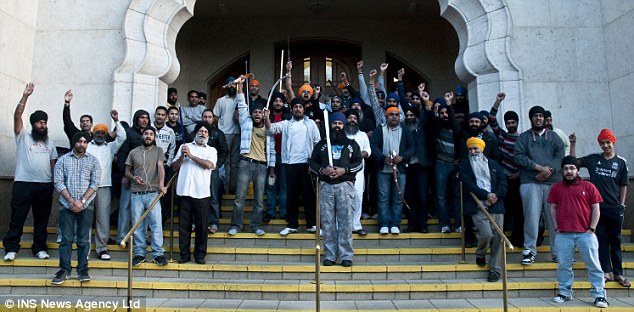 Riots have hit London and a few other cities in the UK over the last three nights causing mayhem, destroying property and leading to looting. Tonight, hundreds of Sikhs are gathering to defend the Gurdware in these cities should they fall under the eye of the looters. It is bringing together Sikhs of all backgrounds and affiliations; promising a glimmer of hope from an otherwise horrible situation.
Riots have hit London and a few other cities in the UK over the last three nights causing mayhem, destroying property and leading to looting. Tonight, hundreds of Sikhs are gathering to defend the Gurdware in these cities should they fall under the eye of the looters. It is bringing together Sikhs of all backgrounds and affiliations; promising a glimmer of hope from an otherwise horrible situation.
To find out more about this mobilisation of Sikhs, go to the Sikh Riot Awareness UK page.
The trigger has been widely recognised as the shooting of a 29 year old black man Mark Duggan in the Tottenham area of North London. 48 hours after his shooting, members of his family, friends and the wider community congregated outside Tottenham Police Station to protest at what they saw as the heavy-handed action of the London Metropolitan Police and the unhelpful communication from them about the matter in the following days. At this gathering of about some 300 protestors, a relatively minor confrontation between a teenager and the Police is said to have ignited running battles that ensued well into the night. A double decker bus was set alight and 49 fires were being dealt with by morning. But more importantly, as a sign of things to come, shops selling household goods, sportswear, toiletries and glasses were looted with CCTV images capturing hooded individuals taking away trollies laden with items.
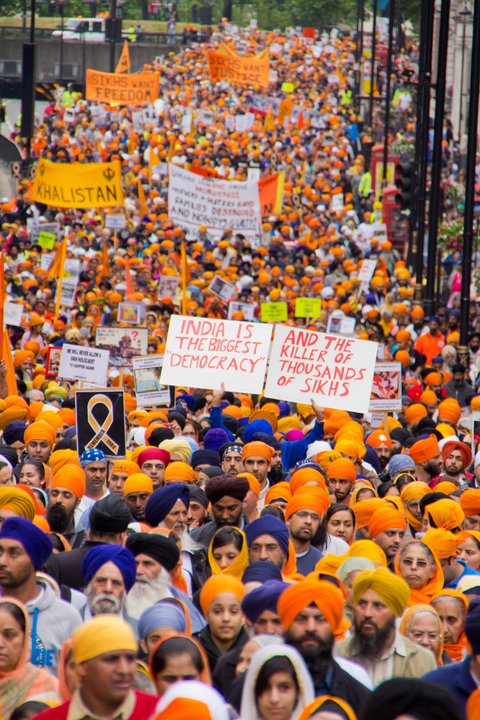 You can repeat your lies….This one comes from the Times of India:
You can repeat your lies….This one comes from the Times of India:
The organisers claimed a figure of 25,000, but the Scotland Yard put the number at 6,000. The ‘Remembrance March’ began at Hyde Park and concluded at Trafalgar Square.[link]
But the truth will get out and you will look all the more stupid for it. Does this look like 6,000? Seems much closer to the 25-35K that was claimed. Sikhs have not forgotten. Until there is justice, Sikhs will never forget.
We will strive for justice for the innocent, such as Professor Bhullar (Watch this powerful video from the WSO’s Annual Parliamentary Dinner; on Professor Bhullar cue to 23:40); we will strive for justice against the guilty.
We live in Bakersfield; we live in Brampton; we live in Birmingham. We still yearn for Bathinda. Our brothers and sisters in London showed it this weekend. Let our brothers and sisters in Punjab know that we are still connected; we will still raise our voices; we still remember.
In Toronto, Lions will roar. A Nation Never Forgets.
An exhibition showcasing British Bhangra music and Culture, titled ‘Soho Road to the Punjab’, will be crossing the pond from the UK to New York City on March 18th 2011 at 6pm. The USA version of the exhibition, Soho Road – Five Rivers to Five Boroughs, will be the world’s first visual arts exhibition inspired by Bhangra music and culture held outside of the UK. The event is being hosted by 92YTribeca and is free to the public.
Originally debuting in Birmingham, UK, Soho Road to the Punjab is an exhibition that includes photography, album sleeves, promotional art and rare prints from South Asian media. This contemporary archive uncovers the worldwide Bhangra phenomenon, showcasing individuals who have championed the UK and USA Bhangra scene.
“Soho Road – from the Five Rivers to the Five Boroughs” is a gift of a title. The Punjab is, of course, the Land of the Five Rivers, while New York iconically comprises Brooklyn, Queens, Manhattan, Staten Island and the Bronx. This is a symmetry just too much too leave alone – it’s a sign! Queens is the largest and the most diverse, and famous as the birthplace of bebop and jazz. Queens also has the largest Sikh population outside California and the highest concentration of Indians anywhere in America. Punjabi is in the top ten of the hundred-odd languages spoken locally, and almost half of all South Asians who live in New York live in Queens. The NY experience will shape the show for the USA. [link]
The event will be held at 92YTribeca, 200 Hudson Street, New York. For more information and to view the exhibition online, see the Facebook page.
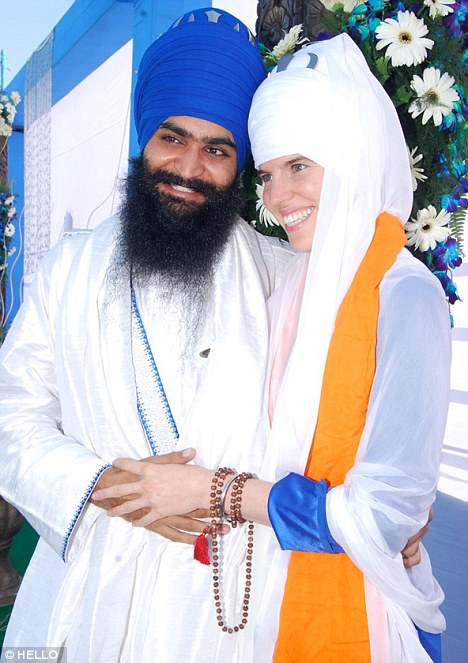 So it is my mother use to tell me. This particular marriage, however, seems to have been made at Darbar Sahib (as close to heaven, as I’ll ever get!). UK’s tabloid press has reported on the wedding of Harvinder Kaur Khalsa (formerly Alexandra Aitken, daughter of disgraced Torty politician Jonathon Aitken) and Inderjot Singh. The picture speaks a thousand words.
So it is my mother use to tell me. This particular marriage, however, seems to have been made at Darbar Sahib (as close to heaven, as I’ll ever get!). UK’s tabloid press has reported on the wedding of Harvinder Kaur Khalsa (formerly Alexandra Aitken, daughter of disgraced Torty politician Jonathon Aitken) and Inderjot Singh. The picture speaks a thousand words.
Just as interesting has been her interest in Sikhi. Below the fold, you’ll find some of her thoughts/observations about her transformation, well worth a read!
Frankly, if someone had told me ten years ago, when I was living the party girl lifestyle in London, that a decade later I’d be a teetotal vegan, I simply wouldn’t have believed them.
If they’d gone on to tell me that I’d also have converted to Sikhism, changed my name to Harvinder Kaur Khalsa and be married to an Indian warrior whom I fell in love with before we even exchanged a single word, I’d have laughed my head off.
After all, I was positively allergic to organised religion. It just seemed so grey to me. But then I don’t really think of Sikhism as a religion, more a path for anyone who is looking for something more spiritual.
Guest Blogged by J. Singh-Sohal
Meeting the Head of the Roman Catholic Church is a once in a life time opportunity, one I fulfilled during the Holy Father’s recent State visit to the UK. I was privileged to be a part of a small gathering that represented all the major world faiths.
It was a special occasion particularly coming so soon after the launch of my recent film Sikhs@War highlighting the role Sikhs Soldiers played for Great Britain during the Great War. I was invited to say a few words, and below is the speech I gave, one which sums up perfectly how I view my Sikh faith and its place in British society.
Meeting Of Religious Leaders and People of Faith with His Holiness Pope Benedict XVI
St Mary’s University College, Twickenham, 17 September 2010
Your Grace. My Lords, ladies and gentleman.
It’s a great pleasure to be here today. To represent the Sikh community at this auspicious occasion is a humbling experience. To be surrounded by the saintly, the religious and the scholarly is a blessing.
I was asked to speak about how being a Sikh influences my daily life. You can see for yourself the greatest way my faith manifests itself. In accordance with being a Sikh, I maintain my outward appearance – with uncut hair under my turban and a beard. They represent living in accordance with God as instructed by the Sikh Gurus. They represent spirituality and discipline.
Not just a symbol but a constant reminder to be upstanding and devote, while always thinking of God. It means wherever I go and whoever I meet I stand out from the crowd – a call to be a responsible Sikh and to help those in need. For me, there’s no hiding my faith. My clothes might change but my identity means people always know I am a Sikh and that I seek to abide by the highest of principles. My Sikh faith has a deep and personal meaning for me, and it shows in everything I do.
Being a Sikh I can never forget those thousands of Sikhs before me who were loyal servants of our country for more than a century and a half. Their Sikh faith instructed them to be saint soldiers – to defend those less fortunate and the weak, to protect the saintly, to stand up against tyranny. Their historic example reminds me daily that faith in God and selfless service to a higher cause is the highest form of living.
One I’m sure we all aspire to. Nor do I forget as a British Sikh that the principles I believe in are Universal Principles – ones that all of the world faiths represented here today share. Belief in God. Selfless service to His Creation. Helping others in need. Being honest and just. The list is endless – a good thing as it shows there is much that unites us all in our devotion to our faiths and to God.
I’ll end by giving the salutation that all Sikhs give – offering their victories, however great or small to the One Lord who is himself the dispeller of Darkness and the true salvation for us all.
Vaheguru Ji Ka Khalsa
Vaheguru Ji Ki Fateh.

